Abstract
BACKGROUND: Conflicting views exist over whether responsiveness of the airways to hypertonic saline relates to non-specific bronchial hyperresponsiveness measured by histamine or methacholine challenge. The bronchoconstrictor responses to exercise and hypertonic saline are reported to be closely related, but the relationship between the symptoms of exercise induced asthma and airway responsiveness to hypertonic saline is not known. METHODS: In 29 asthmatic patients with a history of exercise induced asthma, the response to an ultrasonically nebulised hypertonic saline (3.6% sodium chloride) aerosol, measured as the volume of hypertonic saline laden air required to produce a fall in forced expiratory volume in one second (FEV1) of > or = 20% (PD20), was compared with the concentration of histamine (PC20; group 1) and methacholine (PC20; group 2) producing a 20% fall in baseline FEV1 and exercise induced asthma symptom severity score (groups 1 and 2). The hypertonic responsiveness was determined in a dose-response manner to a maximum dose of 310 1 and the exercise induced asthma symptom severity was scored on a scale of 0-5. RESULTS: Of the 29 patients, 23 (79%) were responsive to the hypertonic saline, with PD20 values ranging from 9 to 310 1. A significant correlation was found between the PD20 hypertonic saline and the exercise induced asthma symptom score. There was no significant correlation between the PD20 response to hypertonic saline and the histamine PC20 or methacholine PC20. The exclusion of those subjects who failed to respond to hypertonic saline improved the relationship between hypertonic saline and methacholine PC20. No significant correlation was found between the exercise induced asthma symptom score and histamine PC20 or methacholine PC20. CONCLUSION: These findings suggest that hypertonic saline responsiveness bears a closer relationship to the severity of exercise induced asthma symptoms than to the non-specific bronchial hyperresponsiveness measured by histamine or methacholine reactivity.
Full text
PDF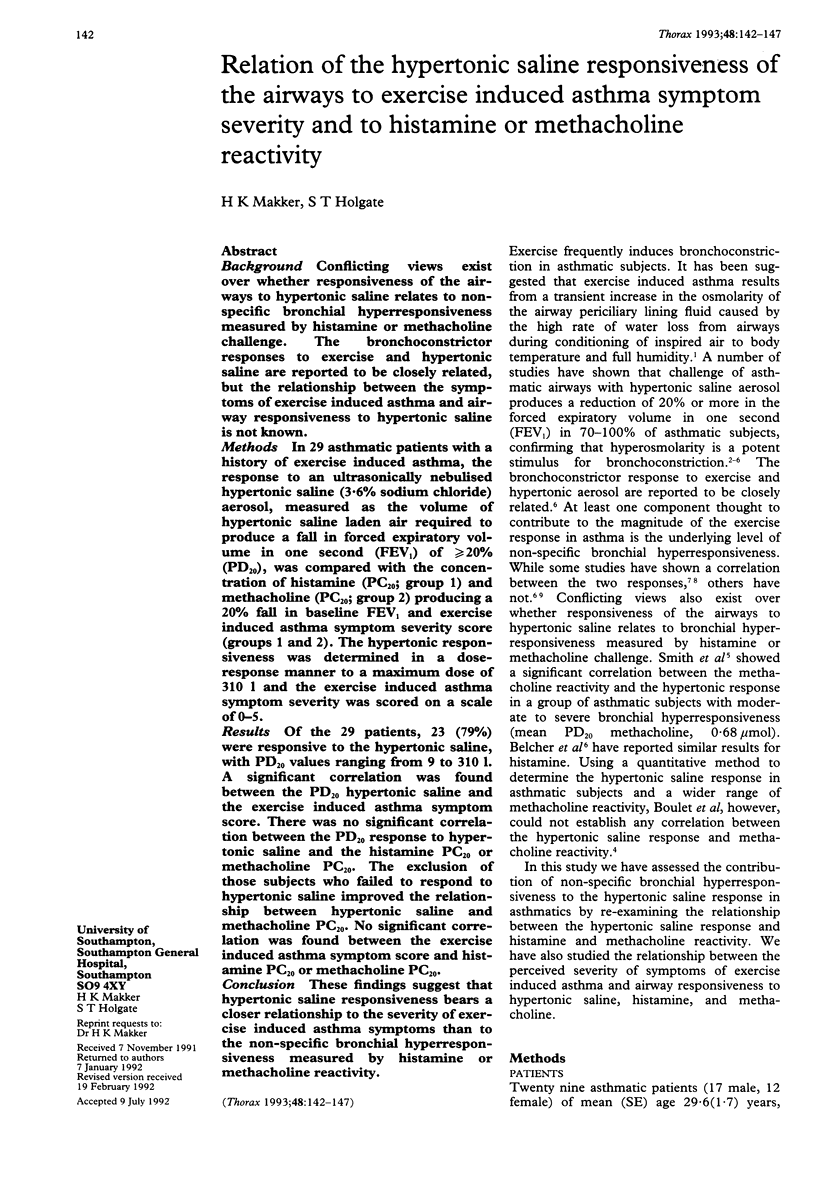

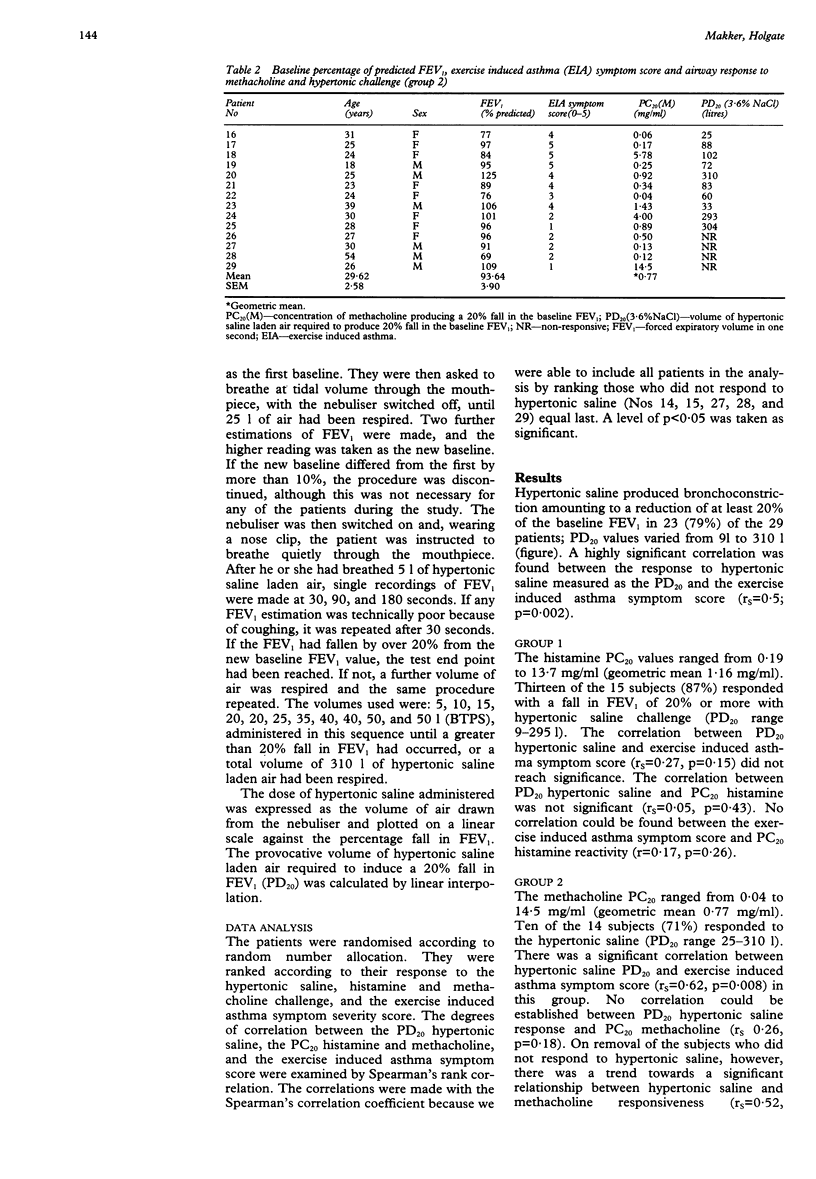
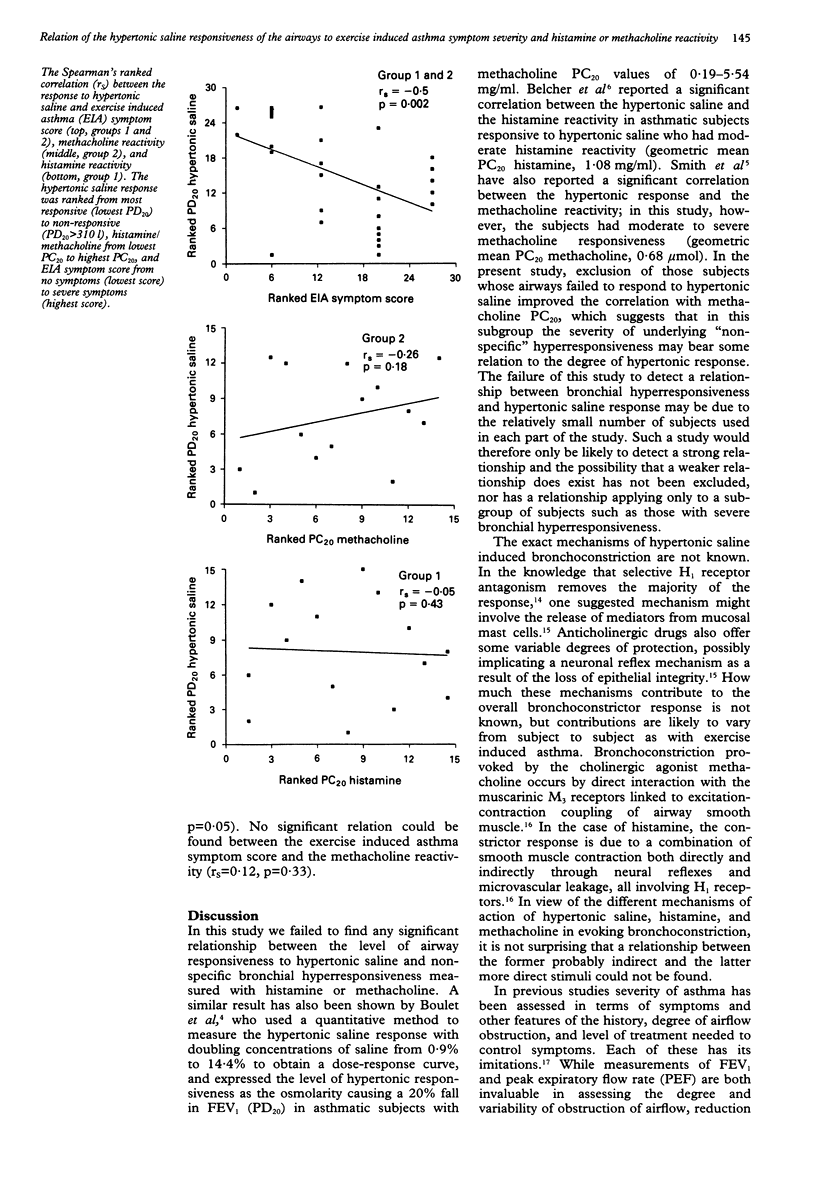
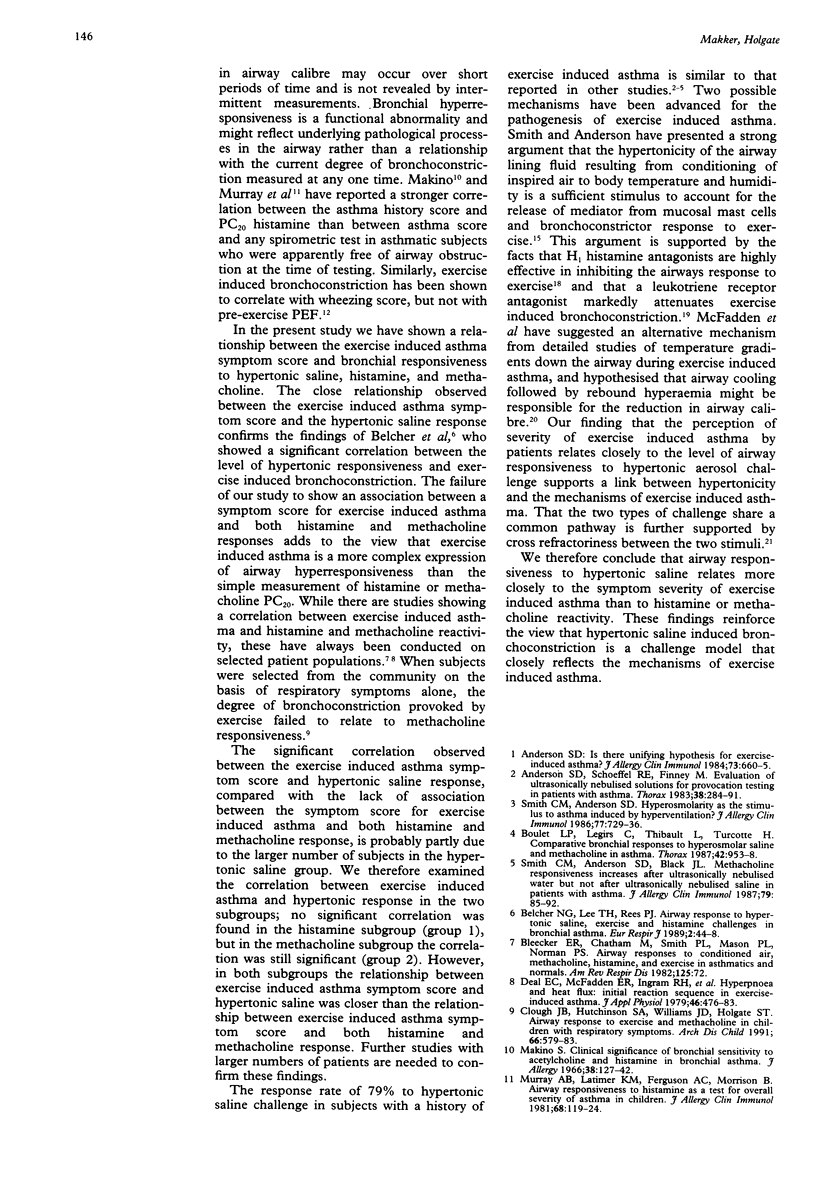
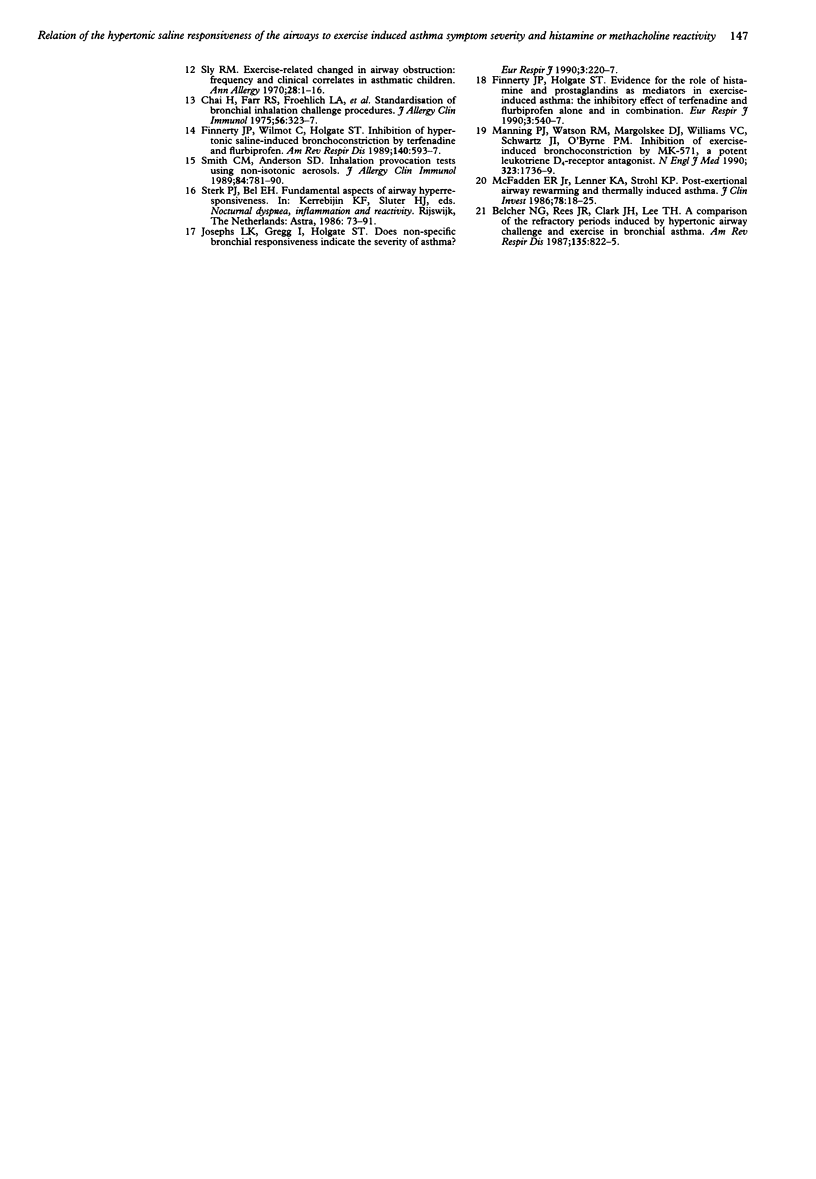
Selected References
These references are in PubMed. This may not be the complete list of references from this article.
- Anderson S. D. Is there a unifying hypothesis for exercise-induced asthma? J Allergy Clin Immunol. 1984 May;73(5 Pt 2):660–665. doi: 10.1016/0091-6749(84)90301-4. [DOI] [PubMed] [Google Scholar]
- Anderson S. D., Schoeffel R. E., Finney M. Evaluation of ultrasonically nebulised solutions for provocation testing in patients with asthma. Thorax. 1983 Apr;38(4):284–291. doi: 10.1136/thx.38.4.284. [DOI] [PMC free article] [PubMed] [Google Scholar]
- Belcher N. G., Rees P. J., Clark T. J., Lee T. H. A comparison of the refractory periods induced by hypertonic airway challenge and exercise in bronchial asthma. Am Rev Respir Dis. 1987 Apr;135(4):822–825. doi: 10.1164/arrd.1987.135.4.822. [DOI] [PubMed] [Google Scholar]
- Boulet L. P., Legris C., Thibault L., Turcotte H. Comparative bronchial responses to hyperosmolar saline and methacholine in asthma. Thorax. 1987 Dec;42(12):953–958. doi: 10.1136/thx.42.12.953. [DOI] [PMC free article] [PubMed] [Google Scholar]
- Chai H., Farr R. S., Froehlich L. A., Mathison D. A., McLean J. A., Rosenthal R. R., Sheffer A. L., Spector S. L., Townley R. G. Standardization of bronchial inhalation challenge procedures. J Allergy Clin Immunol. 1975 Oct;56(4):323–327. doi: 10.1016/0091-6749(75)90107-4. [DOI] [PubMed] [Google Scholar]
- Clough J. B., Hutchinson S. A., Williams J. D., Holgate S. T. Airway response to exercise and methacholine in children with respiratory symptoms. Arch Dis Child. 1991 May;66(5):579–583. doi: 10.1136/adc.66.5.579. [DOI] [PMC free article] [PubMed] [Google Scholar]
- Deal E. C., Jr, McFadden E. R., Jr, Ingram R. H., Jr, Jaeger J. J. Hyperpnea and heat flux: initial reaction sequence in exercise-induced asthma. J Appl Physiol Respir Environ Exerc Physiol. 1979 Mar;46(3):476–483. doi: 10.1152/jappl.1979.46.3.476. [DOI] [PubMed] [Google Scholar]
- Finnerty J. P., Holgate S. T. Evidence for the roles of histamine and prostaglandins as mediators in exercise-induced asthma: the inhibitory effect of terfenadine and flurbiprofen alone and in combination. Eur Respir J. 1990 May;3(5):540–547. [PubMed] [Google Scholar]
- Finnerty J. P., Wilmot C., Holgate S. T. Inhibition of hypertonic saline-induced bronchoconstriction by terfenadine and flurbiprofen. Evidence for the predominant role of histamine. Am Rev Respir Dis. 1989 Sep;140(3):593–597. doi: 10.1164/ajrccm/140.3.593. [DOI] [PubMed] [Google Scholar]
- Josephs L. K., Gregg I., Holgate S. T. Does non-specific bronchial responsiveness indicate the severity of asthma? Eur Respir J. 1990 Feb;3(2):220–227. [PubMed] [Google Scholar]
- Makino S. Clinical significance of bronchial sensitivity to acetylcholine and histamine in bronchial asthma. J Allergy. 1966 Sep;38(3):127–142. doi: 10.1016/0021-8707(66)90036-0. [DOI] [PubMed] [Google Scholar]
- Manning P. J., Watson R. M., Margolskee D. J., Williams V. C., Schwartz J. I., O'Byrne P. M. Inhibition of exercise-induced bronchoconstriction by MK-571, a potent leukotriene D4-receptor antagonist. N Engl J Med. 1990 Dec 20;323(25):1736–1739. doi: 10.1056/NEJM199012203232504. [DOI] [PubMed] [Google Scholar]
- McFadden E. R., Jr, Lenner K. A., Strohl K. P. Postexertional airway rewarming and thermally induced asthma. New insights into pathophysiology and possible pathogenesis. J Clin Invest. 1986 Jul;78(1):18–25. doi: 10.1172/JCI112549. [DOI] [PMC free article] [PubMed] [Google Scholar]
- Murray A. B., Ferguson A. C., Morrison B. Airway responsiveness to histamine as a test for overall severity of asthma in children. J Allergy Clin Immunol. 1981 Aug;68(2):119–124. doi: 10.1016/0091-6749(81)90169-x. [DOI] [PubMed] [Google Scholar]
- Sly R. M. Exercise-related changes in airway obstruction: frequency and clinical correlates in asthmatic children. Ann Allergy. 1970 Jan;28(1):1–16. [PubMed] [Google Scholar]
- Smith C. M., Anderson S. D., Black J. L. Methacholine responsiveness increases after ultrasonically nebulized water but not after ultrasonically nebulized hypertonic saline in patients with asthma. J Allergy Clin Immunol. 1987 Jan;79(1):85–92. doi: 10.1016/s0091-6749(87)80021-0. [DOI] [PubMed] [Google Scholar]
- Smith C. M., Anderson S. D. Hyperosmolarity as the stimulus to asthma induced by hyperventilation? J Allergy Clin Immunol. 1986 May;77(5):729–736. doi: 10.1016/0091-6749(86)90419-7. [DOI] [PubMed] [Google Scholar]
- Smith C. M., Anderson S. D. Inhalation provocation tests using nonisotonic aerosols. J Allergy Clin Immunol. 1989 Nov;84(5 Pt 1):781–790. doi: 10.1016/0091-6749(89)90309-6. [DOI] [PubMed] [Google Scholar]


